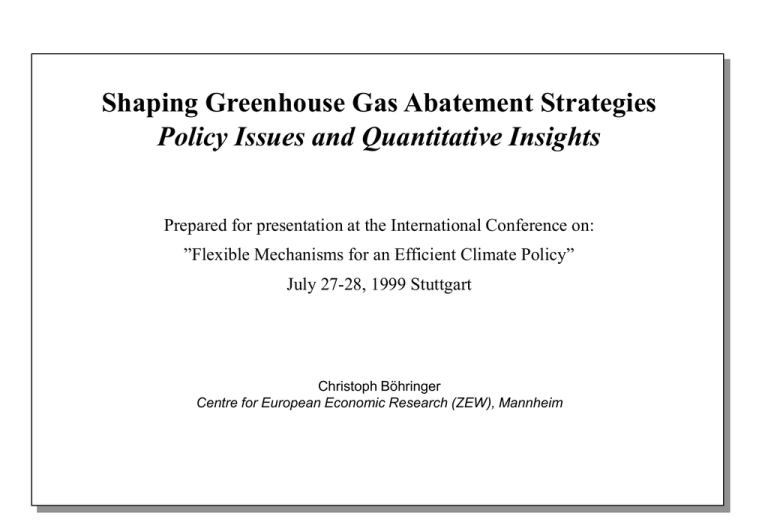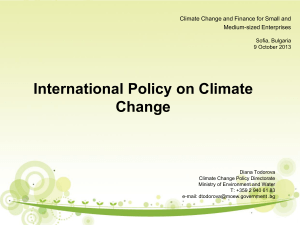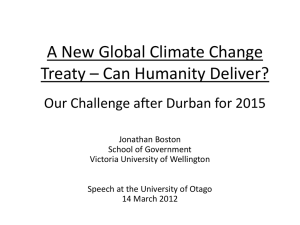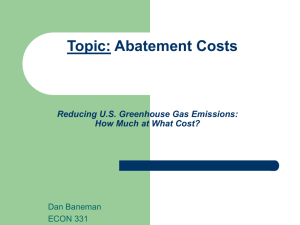cbo
advertisement

Shaping Greenhouse Gas Abatement Strategies Policy Issues and Quantitative Insights Prepared for presentation at the International Conference on: ”Flexible Mechanisms for an Efficient Climate Policy” July 27-28, 1999 Stuttgart Christoph Böhringer Centre for European Economic Research (ZEW), Mannheim Guidelines for Climate Policy: Efficiency (positive) Equity (normative) Insights from Applied Economic Analysis for Decision Making: magnitude of cost distribution of cost efficiency/equity trade off } for alternative policy strategies 1 Policy Guidelines: Efficiency and Equity Motivation and Structure of Presentation Consensus: • Need for policy measures to control GHG concentrations Disagreement: • Critical level of concentration and risks of climate change • Scope and the timing of emission reductions (risk aversion / willingness to pay) Learn then Act (Wait and see) (USA) Act then learn (EU) Need for quantitative cost-benefit analysis 2 Issues: Buying Global Warming Insurance - Total Costs of Abatement Motivation and Structure of Presentation Marginal abatement costs (MAC) Marginal abatement costs (MAC) mac 2 A MAC 2 mac 1 C MAC * B MAC 1 Emissionabatement by 1 Emissionabatement by 2 Δ E/2 Δ E1* Δ E2* ΔE Efficiency losses (MAC 1 MAC 2) 2 Issues:Alternative Policy Instruments - Cost Efficiency Motivation and Structure of Presentation Efficiency Conditions: • Spatial dimension: equalized MAC across sources (regions) ==> where-flexibility Temporal dimension: equalized MAC over time ==> when-flexibility Efficient policy instruments: • Emission taxes: price-based (abatement to be determined) • Emission permits: quantity based (emission price to be determined) • Role of revenue recycling: double dividend debate Need for systematic quantitative cost-effectiveness analysis of alternative policy strategies 2 Issues:Alternative Policy Instruments - Cost Efficiency Motivation and Structure of Presentation Global Warming Global Problem Global Solution: • Need for cooperative approach which includes all major emitters • Cooperation depends on “fair” burden sharing • What does “fair” mean? - Variety of equity criteria “Equity is so hopelessly subjective that it cannot be analyzed scientifically” (Young, 1994) Need for quantitative estimates of the economic implications associated with alternative equity rules 2 Issues:Distribution of Costs - Burden and Sharing Motivation Structure of Presentation Appraisal of Quantitative Models for Climate Policy Analysis: • Operationalization of policy experiments • Consistent analysis of complex mechanism (feed-back, spill-overs) • Systematic sensitivity analysis (robustness test) 3 The Role of Quantitative Economic Analysis Quantified Emission Limits under the Kyoto Protocol: Region Commitments (Percentage of 1990 Base Year Greenhouse Gas Emissions) USA / Canada 93.1 European Union (EU15) 92.0 Japan (JPN), Australia (AUS), New Zealand (NZL) 96.8 Economies in Transition (EIT) 98.3 • No emission constraints for developing countries • Annex B countries keep emissions constant after 2010 • International emissions trading (TRD) versus no trade (NTR) 4 Applied Policy Analysis: Kyoto Impacts of Kyoto on Lifetime Consumption: TRD NTR Annex B Non Annex B World USA/Canada EU 15 JPN/AUS/NZL Economies in Transition India China Other Pacific Asia Middle East/North Africa Sub-Saharan Africa Latin America/Caribbean -2,5 -2 -1,5 -1 -0,5 0 Consumption loss (in % change of BaU) Source: Böhringer 1999 4 Applied Policy Analysis: Kyoto • Significant international spill-over effects • Burden shifting from developed to developing countries via terms of trade - “Income” effect - “Substitution” effect - “Fossil fuel market” effect • TRD reduces total adjustment costs - gains from trade are relatively small due to limited low-cost abatement options • TRD needs not be beneficial for all countries (adverse terms of trade may dominate gains from permit trade) 4 Applied Policy Analysis: Kyoto Beyond Kyoto: • Physical requirement ==> contraction of global emissions: - Further more stringent constraints for the developed countries - Inclusion of developing countries • „Moral“ requirement ==> convergence of per capita rights (egalitarian) Contraction and Convergence: • 30% reduction in global emissions as compared to 1990 levels • Linear convergence of current per capita emission to equal per capita emission rights in 2050 4 Applied Policy Analysis: Beyond Kyoto - Contraction and Convergence Per Capita Emission Rights under Contraction and Covergence: USA/Canada 6 JPN/AUS/NZL EU 15 tons of carbon per capita 5 EIT 4 China 3 Other Pacific Asia Latin America/Caribbean 2 Middle East/North Africa 1 India Sub-Saharan Africa 0 2000 2010 2020 2030 2040 2050 4 Applied Policy Analysis: Beyond Kyoto - Contraction and Convergence Source: Böhringer&Welsch 1999 Impacts of Contraction and Convergence on Lifetime Consumption: TDR NTR World USA/Canada EU 15 JPN/AUS/NZL Economies in Transition India China Other Pacific Asia Middle East/North Africa Sub-Saharan Africa Latin America/Caribbean -15 -10 -5 0 5 10 15 20 Consumption loss (in % change from BaU) Source: Böhringer&Welsch 1999 4 Applied Policy Analysis: Beyond Kyoto - Contraction and Convergence • Large efficiency gains from emissions trading (<== range in marginal abatement costs between 0 and 1500 $US per ton of CO2 in 2050) • Trade in permits is beneficial to all countries Where-flexibility (permit trading) as a no-regret strategy for all countries • Major developing areas improve economic welfare over BaU levels Under trade Contraction and Convergence may be politically feasible 4 Applied Policy Analysis: Beyond Kyoto - Contraction and Convergence Key Determinants of Climate Policy: • Magnitude and distribution of adjustment costs Insights from Applied Economic Analysis: • Flexible instruments provide substantial efficiency gains: Buy a higher level of insurance for the same amount of money Get the same level of climate insurance for significantly less money • Flexibility/Cost-efficiency relaxes the problem of burden sharing: Feasibility of long-term sustainable strategies such as Contraction and Convergence 5 Summary and Conclusions









